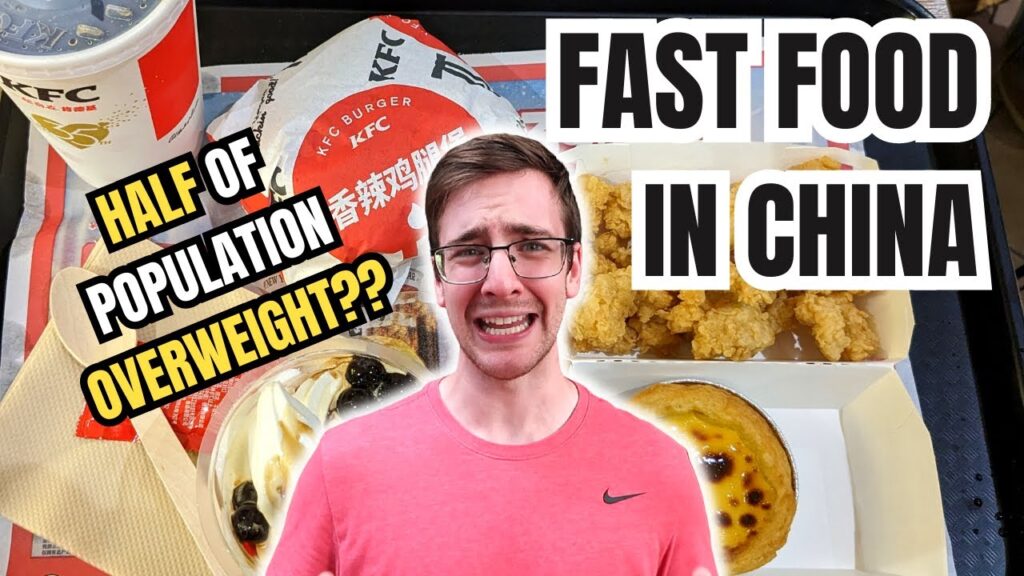Fast food has become an integral part of modern society’s dining habits.
Its convenience, affordability, and accessibility have made it a staple in many people’s lives.
However, as fast food consumption has risen, so too have concerns about its impact on our health, particularly its connection to the rising rates of obesity.
In this comprehensive post, I will delve deep into the complex relationship between fast food and obesity.
Obesity is a global health epidemic with far-reaching consequences, and understanding how fast food contributes to this issue is crucial for individuals and society as a whole.
Through a detailed examination of various aspects, from the nutritional content of fast food to socioeconomic factors and cultural influences, we aim to unveil the intricate web that ties fast food to obesity.
Join us on this journey as we explore the impact of fast food on obesity rates, uncovering the connection that has profound implications for our health and well-being.
See Updated List of all Federal Universities in Nigeria and Courses Offered

Understanding Fast Food
A. Definition of Fast Food
Fast food is a category of food that is known for its quick preparation and service, often prioritizing speed and convenience over nutritional value.
It typically includes items like burgers, fries, pizza, fried chicken, and sugary beverages.
Fast food is commonly served at restaurants and outlets where customers can order and receive their food quickly, either through drive-thru services or in-store dining.
B. Prevalence and Popularity
Fast food has gained widespread popularity worldwide, becoming a cultural phenomenon. Its convenience makes it a go-to choice for busy individuals and families.
The ubiquity of fast food chains in urban and rural areas alike has contributed to its prevalence.
I will explore how this popularity has shaped our dietary habits and, in turn, its connection to obesity rates in later sections.
The Obesity Epidemic
A. Defining Obesity
Obesity is a medical condition characterized by an excessive accumulation of body fat, to the extent that it may have adverse effects on health.
It is typically assessed using the Body Mass Index (BMI), which considers a person’s weight in relation to their height.
Obesity is a multifaceted issue with various contributing factors, and it can lead to a range of health problems, including cardiovascular diseases, diabetes, and musculoskeletal disorders.
B. Global Obesity Trends
The prevalence of obesity has been steadily increasing on a global scale.
I will examine key statistics and trends to understand how obesity rates have evolved over time and how they vary among different regions and demographic groups.
C. Health Consequences
Obesity is not merely a matter of aesthetics; it has severe health consequences.
In this section, I will explore the physical and psychological health issues associated with obesity, shedding light on the significant burden it places on individuals and healthcare systems.
Fast Food and Obesity: The Link
A. Fast Food Consumption Patterns
Understanding the relationship between fast food and obesity begins with an examination of how frequently and in what quantities people consume fast food.
I will go into the patterns of fast food consumption, including factors like frequency of visits, meal choices, and portion sizes.
B. Caloric Density and Nutritional Value
Fast food is often criticized for its high caloric density and poor nutritional value.
This subsection will analyze the nutritional content of typical fast food items, emphasizing their contribution to excessive calorie intake and lack of essential nutrients.
C. Role of Marketing
Fast food chains invest heavily in marketing and advertising.
I will explore the persuasive tactics used to attract consumers, especially children and adolescents, and how these strategies influence fast food consumption and, consequently, obesity rates.
Fast Food Ingredients and Obesity
A. High Sugar Content
Fast food items often contain high amounts of added sugars, contributing to excessive calorie intake.
I will examine the sources of added sugars in fast food, their impact on obesity, and the associated health risks, including diabetes and heart disease.
B. Trans Fats and Saturated Fats
Fast food is notorious for being laden with trans fats and saturated fats, which are harmful to health.
This section will go into the sources of these unhealthy fats in fast food, their effects on cholesterol levels, and their role in promoting obesity and related conditions.
C. Sodium and Obesity
Sodium, commonly found in fast food as salt and flavor enhancers, can lead to water retention and increased blood pressure.
We will investigate how excess sodium intake from fast food can contribute to obesity and its associated health concerns, including hypertension.
Socioeconomic Factors
A. Fast Food Accessibility
Access to fast food outlets is not uniform across all communities.
We will explore how the availability and proximity of fast food restaurants can vary based on geographic location and socioeconomic factors, potentially influencing fast food consumption and obesity rates.
B. Socioeconomic Status and Obesity
Socioeconomic status plays a crucial role in shaping dietary choices and lifestyles.
This subsection will investigate the relationship between socioeconomic status and obesity, examining how income, education, and employment status can impact an individual’s susceptibility to obesity in the context of fast food consumption.
Psychological Aspects
A. Fast Food Addiction
Some individuals develop a psychological dependence on fast food, akin to addiction.
We will go into the concept of fast food addiction, its neurological underpinnings, and how it can perpetuate a cycle of unhealthy eating habits and obesity.
B. Emotional Eating
Emotional eating is a common response to stress, sadness, or other emotions, and fast food often becomes a coping mechanism.
This subsection will explore the connection between emotional eating, fast food consumption, and its contribution to obesity.
I will also discuss strategies for addressing emotional eating patterns.
See How to write Application letter for Teaching Job in School
Fast Food and Childhood Obesity
A. Early Exposure to Fast Food
Children are often introduced to fast food at a young age.
We will investigate how early exposure to fast food can influence their taste preferences, dietary habits, and overall health, potentially setting the stage for obesity.
B. Parental Influence
Parents play a significant role in shaping their children’s eating habits.
This subsection will explore the impact of parental choices and attitudes toward fast food on children’s dietary choices, highlighting the importance of parental guidance in preventing childhood obesity.
Fast Food and Adolescents
A. Peer Pressure and Fast Food
Adolescents often face peer pressure to conform to fast food consumption norms.
We will examine how peer influences can lead to increased fast food consumption among teenagers and its potential consequences on their health.
B. Impact on Adolescent Health
The teenage years are a critical period for growth and development.
This subsection will discuss how frequent fast food consumption during adolescence can impact physical and mental health, including issues like obesity, nutritional deficiencies, and self-esteem.
Fast Food and Adult Obesity
A. Busy Lifestyles and Fast Food
As adults juggle work, family, and other responsibilities, fast food often becomes a convenient choice.
We will explore how the demands of modern life and time constraints can lead to frequent fast food consumption among adults and contribute to obesity.
B. Long-term Health Consequences
This section will delve into the long-term health consequences of regular fast food consumption in adulthood.
We will examine the links between fast food and chronic health conditions such as diabetes, heart disease, and certain cancers, shedding light on the lasting impact of dietary choices on adult health.
Cultural Factors
A. Fast Food in Different Cultures
Fast food is not a uniform concept worldwide; it takes on different forms in various cultures.
We will explore how fast food adapts to local cuisines and preferences, highlighting examples of culturally influenced menu items.
B. Cultural Dietary Habits
This subsection will delve into the dietary habits and traditions within different cultures and how they intersect with fast food consumption.
We will examine how cultural factors, such as food rituals and celebrations, can influence an individual’s propensity for fast food and its impact on obesity rates.
Health Policies and Interventions
A. Government Regulations
Government bodies play a crucial role in regulating the fast food industry.
We will examine the impact of government policies, including menu labeling requirements, restrictions on marketing to children, and taxation, in addressing the fast food and obesity connection.
B. Public Health Campaigns
Public health initiatives aim to educate the public about the health risks associated with fast food consumption.
This subsection will discuss the effectiveness of public health campaigns in raising awareness and promoting healthier dietary choices in the face of the fast food epidemic.
The Role of Education
A. Nutrition Education
Promoting nutritional literacy is essential in addressing the fast food and obesity issue.
We will explore the role of formal education, schools, and community programs in teaching individuals about healthy eating choices and empowering them to make informed decisions.
B. Media Literacy
Media plays a significant role in shaping perceptions and behaviors related to fast food.
This subsection will discuss the importance of media literacy programs and their ability to help individuals critically evaluate fast food advertisements and information, fostering better decision-making regarding food consumption.
Fast Food Alternatives
A. Healthy Fast Food Options
Contrary to popular belief, there are healthier choices available at fast food restaurants.
We will explore options for making nutritious selections from fast food menus, including items with lower calorie counts, reduced sodium, and healthier ingredients.
B. Cooking at Home
One of the most effective ways to combat fast food-related obesity is by cooking meals at home.
This subsection will emphasize the benefits of home-cooked meals, including control over ingredients and portion sizes, and provide practical tips for incorporating home cooking into busy lifestyles.
Economic Implications
A. Healthcare Costs
Obesity-related health issues have significant economic consequences for individuals and healthcare systems.
This subsection will examine the financial burden of treating obesity-related conditions, including healthcare expenditures and the costs of managing chronic diseases.
B. Fast Food Industry
The fast food industry is a major player in the global economy.
We will discuss the economic impact of the fast food industry, including employment opportunities, revenue generation, and the financial interests at stake in addressing the fast food and obesity connection.
The Future of Fast Food and Obesity
A. Trends in Fast Food Industry
The fast food industry is continuously evolving.
We will explore emerging trends such as healthier menu options, sustainable practices, and the use of technology, and assess their potential impact on obesity rates.
B. Prospects for Reducing Obesity
This subsection will discuss potential strategies and initiatives for reducing obesity rates in the context of fast food consumption.
We will examine both individual-level actions and broader societal changes that can contribute to a healthier future in the face of the fast food challenge.
Case Studies
A. Successful Anti-Obesity Initiatives
We will explore case studies of regions, communities, or countries that have successfully implemented anti-obesity initiatives, including policy changes, educational programs, and community engagement efforts.
These real-world examples will provide insights into effective strategies for combatting fast food-related obesity.
B. Communities Combatting Fast Food
This subsection will focus on specific communities or neighborhoods that have taken proactive steps to reduce fast food consumption and its impact on obesity.
By examining grassroots efforts and community-driven initiatives, we can gain valuable lessons and inspiration for addressing this complex issue at the local level.
How does the fast food industry contribute to obesity?
In today’s fast-paced world, the allure of fast food is undeniable. It’s quick, convenient, and tantalizing to the taste buds. However, beneath the surface lies a sinister connection between the fast food industry and the rising obesity epidemic.
In this section, I will go into the ways in which the fast food industry contributes to obesity, shedding light on the hidden factors that make it a formidable adversary to our health.
1. High-Calorie Content: The Unhealthy Culprit
Fast food’s notorious reputation for its high-calorie content is well-deserved.
These meals often come loaded with unhealthy fats, excessive sugar, and sodium levels that defy recommended daily allowances.
Consider this: a typical fast food meal can pack over 1,000 calories, surpassing half of the daily calorie intake an adult should consume.
These calorie bombs are ticking time bombs for our waistlines.
2. Large Portion Sizes: The Temptation to Overindulge
One glance at the portion sizes served at fast food joints, and it’s easy to see how they contribute to overeating.
A single serving of french fries from a fast food restaurant can clock in at over 500 calories. The temptation to indulge in oversized portions can lead to unintended calorie overload, a recipe for weight gain.
3. Convenience: The Double-Edged Sword
Fast food’s greatest allure is its convenience. In our hectic lives, it’s a quick fix for hunger pangs on the go. However, this very convenience can be our downfall.
The ease of grabbing a burger and fries on the way home from work means that many individuals find themselves turning to fast food more frequently than they should, a habit that silently contributes to obesity.
4. Marketing: Targeting Vulnerable Audiences
The fast food industry doesn’t stop at convenience; it invests billions in marketing to children and adolescents.
This marketing often exploits children’s vulnerabilities, tapping into their desires for unhealthy foods and susceptibility to peer influence.
These tactics lure young consumers into a cycle of unhealthy eating habits that can persist into adulthood.
5. Limited Access to Healthy Options
Fast food establishments often cluster in low-income neighborhoods, where healthy food options are scarce.
This lack of access to nutritious alternatives leaves residents with little choice but to rely on fast food for their meals. It’s a vicious cycle that perpetuates obesity within vulnerable communities.
The Harsh Reality: Fast Food and Obesity
Numerous studies have unveiled the undeniable link between fast food consumption and obesity.
For instance, a study published in the journal Pediatrics revealed that children who consumed fast food more than once a week were twice as likely to be obese as those who indulged less than once a month.
The evidence is irrefutable, painting a grim picture of the impact of fast food on our health.
A Call for Responsibility
The fast food industry cannot wash its hands of this crisis. It bears a significant responsibility to mitigate its contribution to obesity.
This includes offering healthier food choices on their menus, reducing portion sizes to more reasonable levels, and adopting more responsible marketing practices, especially when targeting children and adolescents.
Taking Control: A Personal Commitment
While the fast food industry should be held accountable, individuals can also play a vital role in reducing the risk of obesity.
It starts with making conscious choices—limiting the consumption of fast food and opting for healthier alternatives.
By doing so, we take the first steps towards a healthier future for ourselves and the generations to come.
What are the major impacts of fast food?
Fast food, with its convenience and affordability, has become a staple in many people’s diets.
However, it’s crucial to be aware of the potential health risks associated with regular consumption of these quick meals.
Obesity: A Weighty Concern
One of the major impacts of fast food is its contribution to obesity.
Fast food is often laden with high-calorie content, unhealthy fats, excessive sugar, and sodium.
These nutritional elements can significantly contribute to weight gain and obesity, a condition that serves as a precursor to various chronic diseases.
Among these are heart disease, stroke, type 2 diabetes, and certain types of cancer.
A Heartfelt Concern: Heart Disease
Fast food can be a culprit in the development of heart disease. It tends to elevate cholesterol levels and increase blood pressure, both known risk factors for cardiovascular issues.
Stroke: A Potentially Fast Food-Induced Risk
The consumption of fast food can also elevate the risk of stroke. It does so by damaging blood vessels, making them more prone to clotting.
Diabetes Dilemma
Type 2 diabetes is another health concern linked to fast food consumption.
These meals can impair insulin sensitivity, a crucial bodily function. Insulin helps the body utilize glucose for energy, and when this process is hindered, it can lead to the development of type 2 diabetes.
Cancer Connection
Certain types of cancer, particularly colorectal cancer, have been associated with fast food consumption, particularly due to the consumption of processed meats, which are prevalent in many fast food options.
Beyond the Obvious: Other Health Issues
The impact of fast food goes beyond the most apparent health concerns.
It has been linked to various other health problems, including digestive issues, depression, and sleep disturbances.
These often stem from the low nutritional value and high content of unhealthy ingredients in fast food.
Environmental Concerns
In addition to health impacts, fast food also has a negative environmental footprint. Fast food restaurants generate substantial amounts of waste, and their reliance on processed ingredients contributes to climate change due to factors like transportation and resource-intensive food production.
It’s essential to remember that not all fast food is created equal.
Some establishments offer healthier alternatives, such as grilled chicken sandwiches and salads.
Nevertheless, it remains critical to be mindful of portion sizes and opt for healthier side dishes and beverages when indulging in fast food.
If you’re concerned about the health risks associated with fast food, the best course of action is to limit your consumption and make conscious choices by selecting healthier food options whenever possible.
Prioritizing a balanced and varied diet is key to maintaining good health in a world where fast food often beckons with its convenience and allure.
Does fast food cause child obesity?
Fast food undoubtedly plays a significant role in the growing problem of child obesity.
Its high calorie content, unhealthy fats, sugar, and sodium levels, coupled with its low nutritional value, create a perfect storm for weight gain and obesity in children.
This article explores the profound impact of fast food on child obesity and offers guidance for concerned parents.
The Fast Food Dilemma: A Recipe for Child Obesity
Fast food, characterized by its calorie-dense and nutrient-poor offerings, poses a grave risk to children’s health.
Regular consumption of these meals can result in excessive calorie intake, leading to weight gain and obesity—a primary risk factor for various chronic diseases, including heart disease, stroke, type 2 diabetes, and specific cancer types.
Scientific Evidence: Fast Food and Childhood Obesity
Numerous studies have revealed a compelling link between fast food consumption and child obesity.
For instance, a study published in the journal Pediatrics found that children who consumed fast food more than once a week were twice as likely to be obese as those who indulged less than once a month.
Another study, featured in Childhood Obesity, highlighted that children residing in areas saturated with fast food restaurants were at a higher risk of obesity compared to those in regions with fewer such establishments.
Understanding the Contributors
Several factors contribute to fast food’s role in child obesity:
- Convenience and Affordability: Fast food is often a quick and budget-friendly option for busy families, making it an appealing choice.
- Targeted Marketing: Fast food chains skillfully market their products to children, using attractive and enticing strategies that resonate with young consumers.
- Large Portion Sizes: Fast food portions are notoriously large, making it easy for children to consume excessive calories unknowingly.
Empowering Parents: Tips for Reducing Fast Food Consumption
Parents can take proactive steps to reduce their children’s exposure to fast food and promote healthier eating habits:
- Limit Fast Food Intake: Restrict the number of times your children eat fast food each week.
- Choose Healthier Options: When you do opt for fast food, select healthier alternatives like grilled chicken sandwiches and salads.
- Avoid Supersized Meals: Refrain from ordering supersized meals and sugary drinks.
- Promote Healthy Home Snacking: Ensure your home is stocked with nutritious snacks and beverages to discourage fast food cravings.
- Educate and Communicate: Talk to your children about the importance of eating nutritious foods and staying physically active.
Seeking Professional Guidance
If you have concerns about your child’s weight and eating habits, it’s advisable to consult their doctor.
A healthcare professional can assist you in devising a tailored plan that includes a balanced diet and appropriate exercise regimen to address your child’s specific needs.
Can eating too fast cause obesity?
Indeed, the pace at which you consume your meals can significantly impact your risk of obesity.
Eating too quickly can have several detrimental effects on your body and its ability to regulate hunger and satiety.
Let’s explore why eating too fast can lead to obesity and how you can make positive changes.
1. Overeating due to Delayed Fullness
When you eat too rapidly, your body doesn’t have adequate time to signal that it’s full.
This delay in registering fullness can result in overeating because you continue to consume food even when your body has had enough.
2. Bloating and False Fullness
Eating quickly often leads to swallowing excess air, which can cause bloating and gas. This sensation can mimic a feeling of fullness, even though it’s not genuine satiety.
3. Hormone Disruption
The pace at which you eat can disrupt the release of hormones that regulate appetite and satiety.
Eating too fast can interfere with the body’s natural ability to balance these hormones, leading to increased feelings of hunger shortly after a meal.
Scientific Evidence: Eating Speed and Obesity
Multiple studies have demonstrated a strong link between fast eating and obesity:
- A study published in the journal Obesity found that individuals who ate the fastest were 115% more likely to be obese than those who consumed their meals at a slower pace.
- Another study, featured in PLoS One, revealed that fast eaters tended to have higher body mass indexes (BMI) and larger waist circumferences.
Practical Tips to Slow Down Your Eating Pace
If you’re concerned about your weight or simply want to adopt healthier eating habits, here are some effective strategies to help you eat more slowly:
- Pause Between Bites: Put down your fork or spoon between each mouthful. This simple act encourages you to savor your food and allows your body to signal fullness.
- Chew Thoroughly: Take the time to chew your food thoroughly. This not only aids in digestion but also prolongs the eating process.
- Take Breaks: During your meal, take short breaks to engage in conversation or sip water. These pauses can help you become more mindful of your eating pace.
- Minimize Distractions: Avoid distractions such as television, smartphones, or work during meals. Focus on your food and the experience of eating.
While it may take some practice to adjust to a slower eating pace, the long-term benefits are well worth the effort.
Slowing down your eating can assist in weight management, enhance digestion, and reduce the risk of developing chronic diseases.
By being mindful of your eating speed, you empower yourself to make healthier choices and foster a more balanced relationship with food.
Summary and Key Takeaways
A. Recap of Main Points
In this comprehensive exploration of the impact of fast food on obesity rates, we’ve covered a wide range of topics.
This section will provide a concise recap of the key points discussed throughout the article, highlighting the most critical findings and insights.
B. Call to Action
As we conclude this post, I’ll issue a call to action.
This will emphasize the importance of acknowledging the connection between fast food and obesity and encourage individuals, communities, policymakers, and the fast food industry itself to take proactive steps towards healthier choices and a reduction in obesity rates.
FAQs
A. What is the main link between fast food and obesity?
- This FAQ will address the fundamental connection between fast food consumption and obesity, highlighting key factors that contribute to this link.
B. Can fast food be consumed in moderation without causing obesity?
- We will provide insights into whether it is possible to incorporate fast food into one’s diet in moderation without increasing the risk of obesity and offer guidelines for making healthier fast food choices.
C. How can individuals make healthier fast food choices?
- This FAQ will offer practical tips and strategies for individuals who want to make healthier choices when dining at fast food restaurants, including menu selections and portion control.
D. What are the long-term health effects of regular fast food consumption?
- Here, we will discuss the potential long-term health consequences of consistent fast food consumption, such as chronic diseases and their impact on overall well-being.
E. What are some effective strategies to combat fast food-related obesity?
- In this FAQ, we will summarize effective strategies and interventions, both at the individual and societal levels, for combatting fast food-related obesity, drawing from the insights provided throughout the article.
Conclusion
In the journey through this comprehensive exploration of “The Impact Of Fast Food On Obesity Rates – Unveiling the Connection,” we’ve uncovered a complex tapestry of factors that contribute to the obesity epidemic, intricately linked to the consumption of fast food.
From the definition of fast food to its nutritional content, from psychological aspects to cultural influences, we’ve examined the multifaceted nature of this issue.
It is evident that fast food and obesity share a profound connection, impacting individuals, communities, and societies at large.
Obesity, with its numerous health consequences, poses a significant challenge to public health worldwide.
However, amid these challenges, there is hope.
We’ve seen how successful initiatives, both on a large scale and at the community level, have made strides in combatting fast food-related obesity.
The trends in the fast food industry are evolving, offering opportunities for healthier options and practices.
Education and media literacy can empower individuals to make informed choices, while government policies and public health campaigns can drive meaningful change.
As we conclude, we issue a call to action. Recognizing the link between fast food and obesity is just the beginning.
It is incumbent upon individuals, communities, policymakers, and the fast food industry itself to take proactive steps.
We must work collectively to promote healthier choices, reduce obesity rates, and improve the overall health and well-being of society.
In the face of this complex challenge, our collective efforts can pave the way for a future where fast food and obesity are no longer inseparable, where healthier choices are accessible to all, and where well-being prevails.
Also see:
The Benefits of Regular Exercise on Mental Health
The Ethical Implications of Artificial Intelligence






